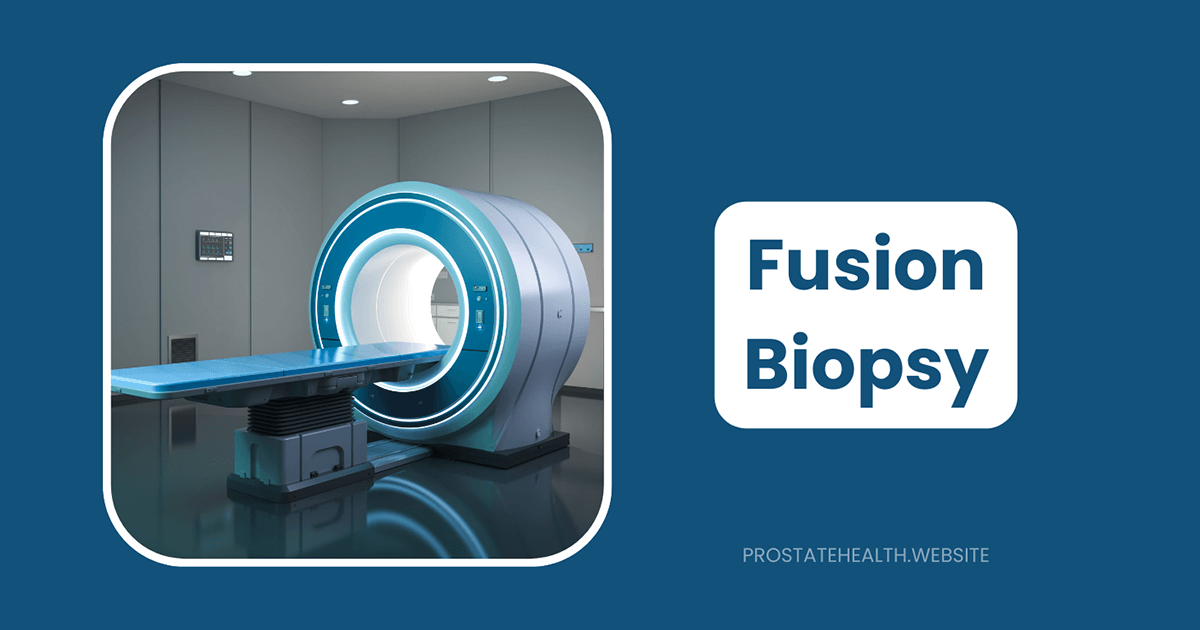Fusion Biopsy Technology: Improving Prostate Cancer Detection

When it comes to prostate cancer, early and accurate detection can make all the difference. Yet for decades, men have endured the limitations of conventional prostate biopsies—procedures that often miss significant cancers or lead to unnecessary repeat biopsies and treatments.
Enter fusion biopsy technology, a game-changing approach that’s revolutionizing how we detect and diagnose prostate cancer. By combining the detailed imaging of MRI with the real-time guidance of ultrasound, this innovative technology is helping men get more accurate diagnoses with less discomfort and uncertainty.
As someone who’s spoken with hundreds of men about their prostate cancer journeys, I’ve heard firsthand how this technology is transforming the diagnostic experience. Let’s explore how fusion biopsy works, its benefits, and what you can expect if your doctor recommends this procedure.
The Problem with Traditional Prostate Biopsies
Before diving into fusion technology, it’s important to understand the limitations of conventional approaches:
Traditional Transrectal Ultrasound (TRUS) Guided Biopsy
For decades, the standard approach to prostate biopsy has been the TRUS-guided method, which uses ultrasound to visualize the prostate while a needle collects tissue samples. While this approach has helped diagnose countless cases of prostate cancer, it has significant drawbacks:
- Random sampling: The procedure typically takes 10-12 samples in a systematic but essentially random pattern
- Limited detection rates: Only detects cancer in 30-40% of cases
- Even lower accuracy for larger prostates: Detection rates drop to 30% or less for prostates larger than 40cc
- Missed significant cancers: Up to 30% of clinically significant cancers are missed
- Overdetection of insignificant cancers: Often finds small, slow-growing cancers that may never cause problems
- Need for repeat biopsies: Many men undergo multiple biopsies over several years
As John, a 62-year-old patient, told me: “I had three negative traditional biopsies over five years while my PSA kept rising. It wasn’t until I had a fusion biopsy that they finally found my cancer. I wish I’d known about this technology years earlier.”
What Is Fusion Biopsy Technology?
Fusion biopsy technology, also known as MRI-ultrasound fusion biopsy, represents a significant advancement in prostate cancer detection. This approach combines two powerful imaging technologies:
- Multiparametric MRI (mpMRI): A detailed scan that identifies suspicious areas in the prostate
- Real-time ultrasound: Provides live imaging during the biopsy procedure
The “fusion” happens when specialized software overlays the previously obtained MRI images onto the real-time ultrasound feed, creating a comprehensive 3D map of the prostate that highlights suspicious areas. This allows the urologist to precisely target these areas for biopsy rather than taking random samples.
According to the latest 2025 research published in the Journal of Urology, fusion biopsy technology can detect clinically significant prostate cancer with up to 85% sensitivity when performed by experienced operators—a substantial improvement over traditional methods.
How the Fusion Biopsy Procedure Works
The fusion biopsy process typically involves two main steps:
Step 1: The MRI Scan
First, you’ll undergo a multiparametric MRI of the prostate. This specialized scan:
- Takes approximately 30-45 minutes
- Doesn’t require any needles or invasive procedures
- Uses powerful magnets and radio waves to create detailed images
- May involve an injection of contrast material to enhance image quality
- Is interpreted by a radiologist who identifies and grades suspicious areas using the PI-RADS (Prostate Imaging-Reporting and Data System) scale
The radiologist marks suspicious areas on the MRI, assigning them a score from 1 to 5, with higher numbers indicating a greater likelihood of clinically significant cancer.
Step 2: The Fusion-Guided Biopsy
Once the MRI has identified target areas, you’ll return for the actual biopsy procedure:
- You’ll be positioned either on your side or on your back, depending on the approach (transrectal or transperineal)
- The MRI images are loaded into the fusion system
- A real-time ultrasound probe is used to scan your prostate
- The fusion software aligns the MRI and ultrasound images
- The urologist uses the fused images to guide the biopsy needle precisely to the suspicious areas
- Targeted samples are taken from the suspicious areas
- Additional systematic samples may be taken from standard locations
The entire procedure typically takes 15-30 minutes and is usually performed under local anesthesia, though sedation options are available for those who prefer them.
The Two Approaches to Fusion Biopsy
There are two main approaches to performing a fusion biopsy:
Transrectal Approach
- The ultrasound probe and biopsy needle are inserted through the rectum
- More commonly performed and widely available
- Typically requires only local anesthesia
- Higher risk of infection (though still relatively low)
Transperineal Approach
- The biopsy needle is inserted through the perineum (the area between the scrotum and rectum)
- Becoming increasingly popular due to lower infection rates
- Better access to the anterior (front) portion of the prostate
- May require deeper sedation or general anesthesia
- According to 2025 European Association of Urology guidelines, this approach is now preferred due to its safety profile
Recent studies show that the transperineal approach detects more clinically significant cancers, particularly in the anterior zone of the prostate, with detection rates of 86% compared to 73% for the transrectal approach.
Benefits of Fusion Biopsy Technology
The advantages of fusion biopsy over traditional approaches are substantial:
1. Higher Detection Rates for Significant Cancer
- Overall detection rate: 55% compared to 30-40% for traditional biopsies
- For smaller prostates (<40cc): Detection rates as high as 71%
- For previously negative biopsies: 42% detection rate in men who had prior negative traditional biopsies
2. More Precise Targeting
- Allows urologists to specifically target suspicious areas identified on MRI
- Reduces the number of samples needed while improving accuracy
- Particularly valuable for hard-to-reach areas like the anterior prostate
3. Better Risk Stratification
- Helps distinguish between aggressive cancers that need treatment and indolent cancers that can be monitored
- Provides more accurate Gleason grading due to targeted sampling
- Reduces both overdiagnosis of insignificant cancers and underdiagnosis of significant ones
4. Fewer Repeat Biopsies
- More accurate initial results mean fewer men need to undergo multiple biopsies
- Reduces anxiety, discomfort, and potential complications from repeated procedures
5. Improved Treatment Planning
- More precise knowledge of tumor location and extent helps guide treatment decisions
- Better information for considering focal therapy options
- Enhanced ability to perform nerve-sparing procedures when appropriate
As Robert, a 58-year-old patient who underwent fusion biopsy in 2025, shared: “The traditional biopsy missed my cancer completely. The fusion biopsy not only found it but showed exactly where it was located, which helped my surgeon preserve my nerve bundles during surgery. I’m cancer-free now with my quality of life intact.”
Who Should Consider a Fusion Biopsy?
Fusion biopsy technology is particularly beneficial for:
Men with Elevated PSA and Previous Negative Biopsies
If you’ve had one or more negative traditional biopsies but your PSA remains elevated or continues to rise, a fusion biopsy offers a 42% chance of finding cancer that was previously missed.
Men with Large Prostates
Traditional biopsies are less effective in larger prostates, with detection rates dropping significantly as prostate size increases. Fusion technology helps overcome this limitation by precisely targeting suspicious areas regardless of prostate size.
Men Considering Active Surveillance
For men diagnosed with low-risk prostate cancer who are considering active surveillance, a fusion biopsy provides more confidence that no higher-grade cancer has been missed.
Men with Suspicious Findings on MRI
If your MRI shows PI-RADS 3, 4, or 5 lesions (moderately to highly suspicious), a fusion biopsy offers the most accurate way to determine if these areas contain cancer.
First-Time Biopsy Candidates
Increasingly, fusion biopsy is being recommended even for initial biopsies, particularly for men with:
- PSA density >0.15 (PSA level divided by prostate volume)
- Suspicious findings on digital rectal exam
- Family history of aggressive prostate cancer
- African American ethnicity (who face higher risk of aggressive disease)
Limitations and Considerations
While fusion biopsy technology offers significant advantages, it’s important to understand its limitations:
Availability and Access
- Not yet available at all medical centers
- May require referral to specialized centers
- Insurance coverage varies, though it has improved significantly since 2023
Operator Dependence
Research from 2025 shows that detection rates improve significantly with operator experience:
- Early experience (first 50 cases): 12% detection of significant cancer
- Intermediate experience (51-100 cases): 18% detection
- Advanced experience (>100 cases): 25% detection
This highlights the importance of seeking experienced providers when possible.
Cost Considerations
- Generally more expensive than traditional biopsies
- Requires both MRI and specialized fusion equipment
- Most insurance plans now cover the procedure, but out-of-pocket costs may be higher
Not Perfect Detection
- Even with fusion technology, some cancers may still be missed
- False negatives can occur, particularly with very small tumors
- Interpretation of MRI findings varies between radiologists
The Patient Experience: What to Expect
Having spoken with many men who’ve undergone fusion biopsies, here’s what you can typically expect:
Before the Procedure
- MRI preparation: You’ll need to lie still for 30-45 minutes during the MRI. Some centers offer headphones with music to make this more comfortable.
- Medication adjustments: You may need to temporarily stop blood thinners before the biopsy portion. Always consult with your doctor about medication management.
- Bowel preparation: For transrectal approaches, you’ll likely need to use an enema before the procedure. This is less common for transperineal approaches.
- Antibiotics: You’ll be prescribed antibiotics to reduce infection risk, typically starting the day before the procedure.
During the Biopsy
- Positioning: You’ll be positioned either on your side or on your back, depending on the approach.
- Anesthesia: Local anesthesia will be administered to minimize discomfort. Some centers offer sedation options for anxious patients.
- The procedure: Most men report feeling pressure and mild discomfort rather than sharp pain. The targeted portion typically involves fewer samples than a traditional biopsy.
- Duration: The actual biopsy procedure usually takes 15-30 minutes, though preparation and setup add to the total time.
After the Procedure
- Recovery: Most men can return home shortly after the procedure and resume light activities the same day.
- Side effects: Common side effects include:
- Blood in urine (typically resolves within a few days)
- Blood in semen (may persist for several weeks)
- Blood in stool (for transrectal approach)
- Mild soreness at the biopsy site
- Results: Biopsy results are typically available within 3-7 days.
The Future of Fusion Biopsy Technology
Fusion biopsy technology continues to evolve rapidly. Here are some exciting developments from 2025:
Micro-Ultrasound Integration
The OPTIMUM trial presented at the European Association of Urology Congress 2025 showed that high-resolution micro-ultrasound, which has three times greater resolution than conventional ultrasound, can be integrated with fusion technology to further improve detection.
Artificial Intelligence Enhancement
AI algorithms are being developed to:
- Improve MRI interpretation
- Better identify suspicious areas
- Enhance real-time fusion accuracy
- Predict cancer aggressiveness from imaging features
Single-Session Workflows
Newer systems are enabling “one-stop” approaches where the MRI and biopsy can be performed in a single visit, reducing patient burden and accelerating diagnosis.
Improved Accessibility
As technology costs decrease and more urologists gain experience, fusion biopsy is becoming more widely available, even in community settings.
Making an Informed Decision
If you’re facing a prostate biopsy decision, here are key questions to discuss with your doctor:
- Is fusion biopsy technology available at your facility?
- How many fusion biopsies has your urologist performed?
- Which approach (transrectal or transperineal) do they recommend for your situation?
- Will they perform both targeted and systematic biopsies?
- What anesthesia options are available?
- Is the procedure covered by your insurance?
- What is their protocol for infection prevention?
Conclusion: A Significant Advance in Prostate Cancer Detection
Fusion biopsy technology represents one of the most significant advances in prostate cancer diagnosis in recent decades. By combining the anatomical detail of MRI with the real-time guidance of ultrasound, it offers a more precise, targeted approach to prostate biopsy.
For men with elevated PSA levels or other prostate cancer risk factors, this technology provides greater confidence in biopsy results, reduces the need for repeat procedures, and helps ensure that significant cancers aren’t missed while avoiding overdiagnosis of insignificant ones.
As Michael, a 64-year-old patient who underwent fusion biopsy in early 2025, told me: “The peace of mind from knowing we’ve thoroughly checked my prostate with the most advanced technology available is invaluable. Even though my biopsy found cancer, I’m grateful it was found early and accurately, giving me the best chance for successful treatment.”
Have you or a loved one experienced fusion biopsy technology? Share your experience in the comments below to help other men navigating this journey.






